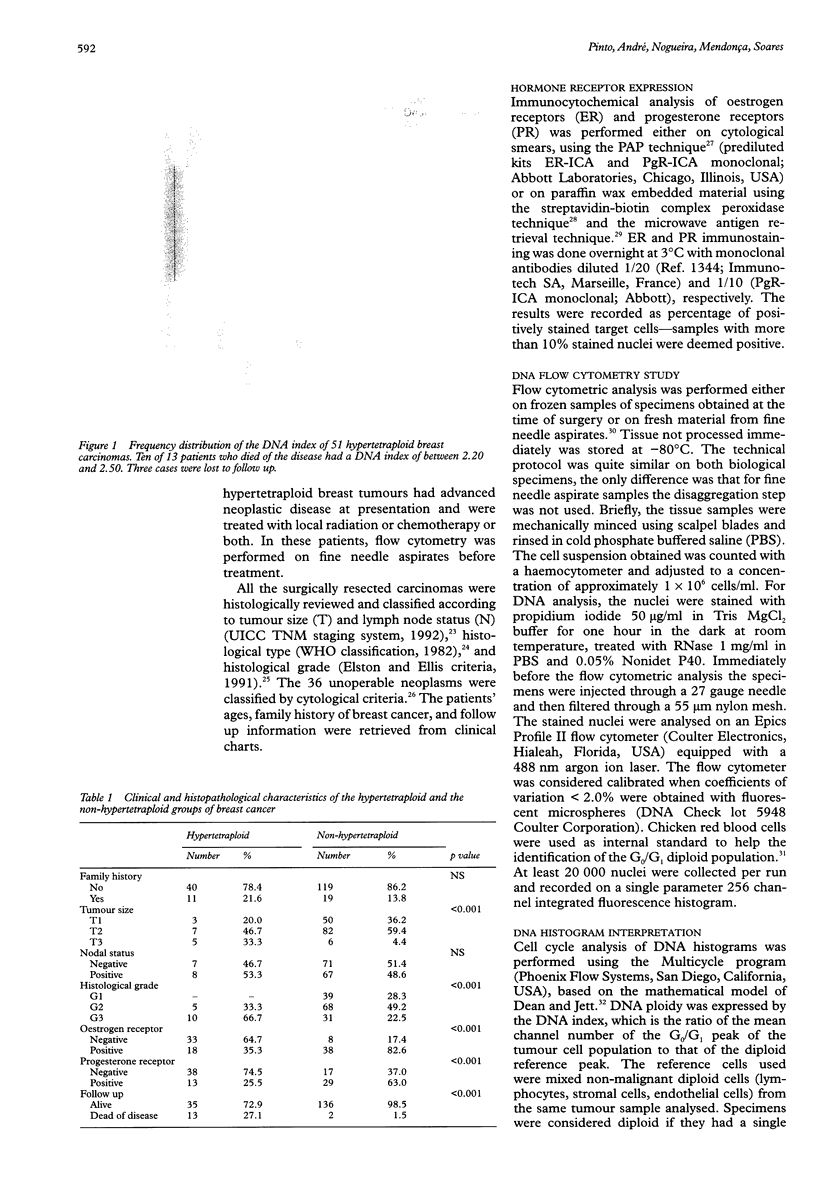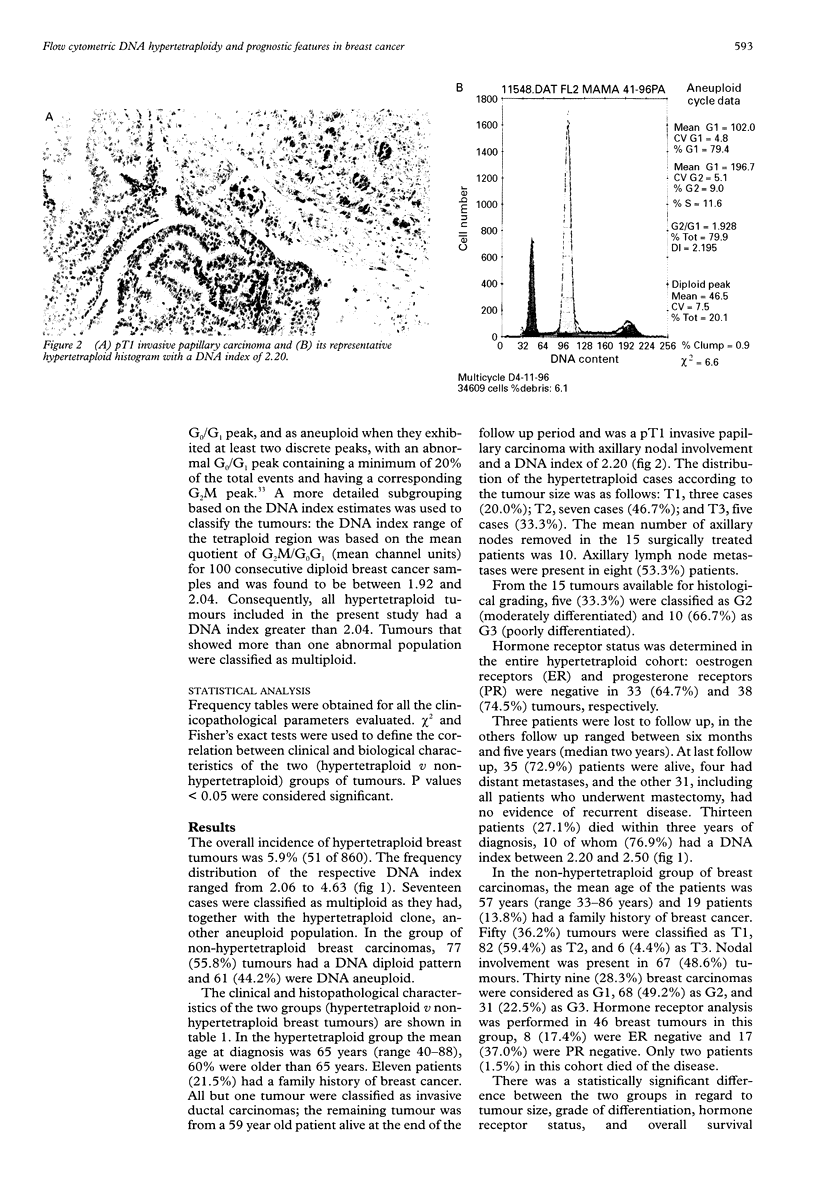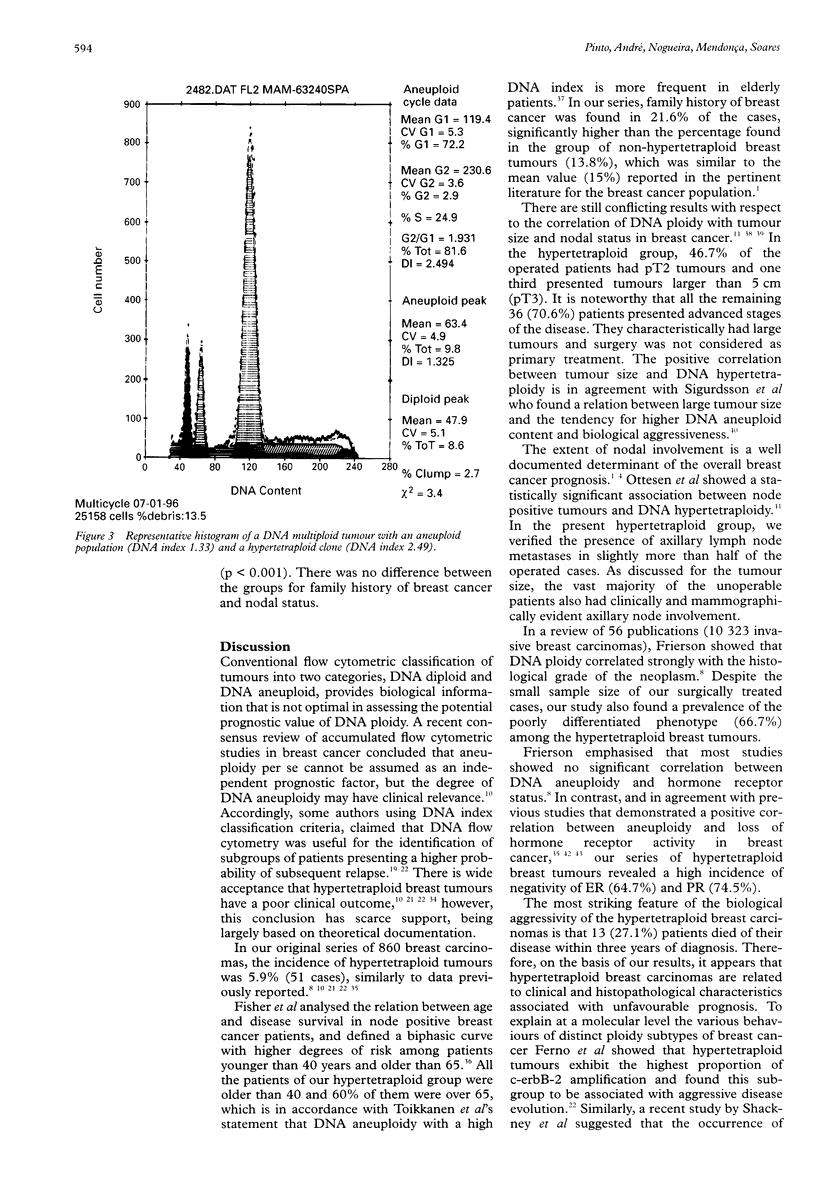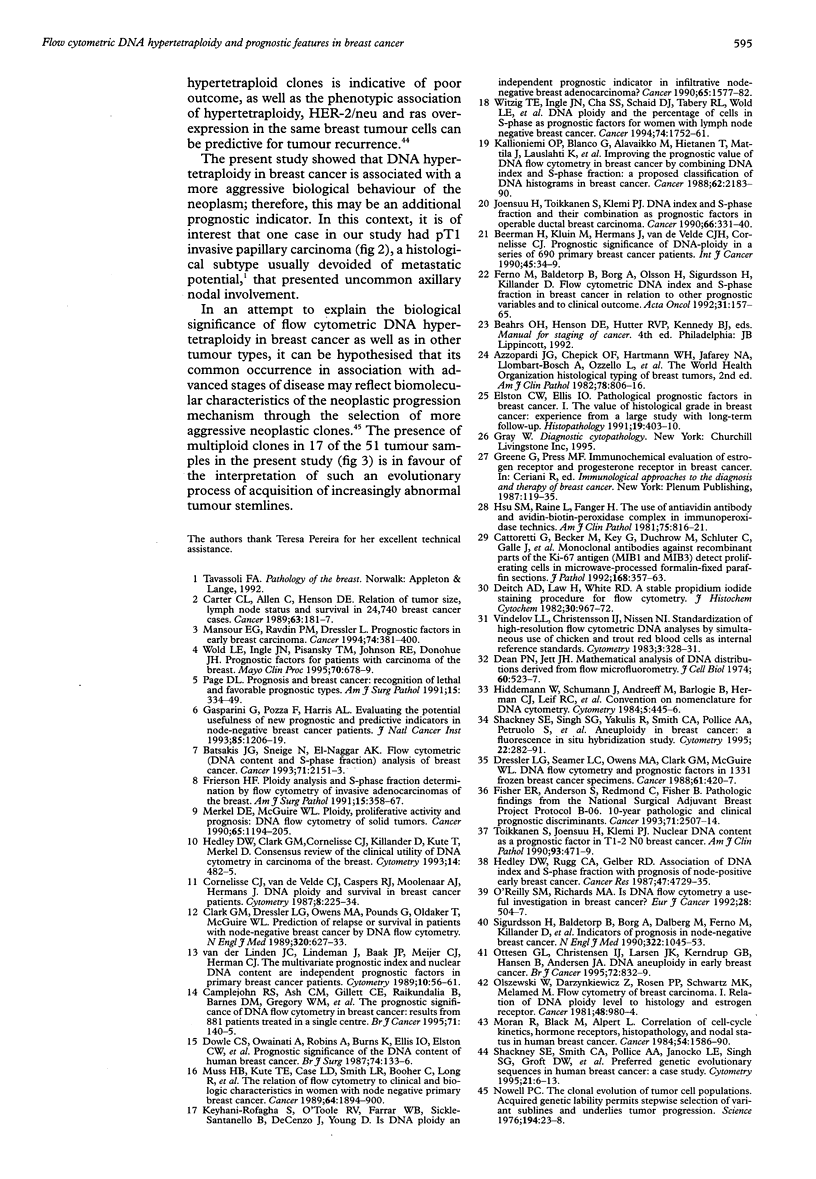Abstract
AIM: Breast tumours with a DNA content higher than 4N (hypertetraploidy) are not well characterised. The aim of this study was to evaluate the clinical and biological characteristics of 51 hypertetraploid breast carcinomas selected from a series of 860 consecutive cases analysed by flow cytometry. METHODS: The clinicopathological characteristics of the hypertetraploid group were compared with those of a control group of 138 non-hypertetraploid breast carcinomas. Breast tumours from patients submitted to surgery as primary therapeutic approach (15 hypertetraploid and the 138 non-hypertetraploid) were TNM staged and classified according to the histological type and grade. The remaining 36 patients had advanced neoplastic disease at presentation and were classified by cytological criteria only. DNA flow cytometric analysis was performed on fresh-frozen samples stained with propidium iodide. Hormone receptors were analysed by immunocytochemistry. RESULTS: The incidence of hypertetraploid breast tumours was 5.9% (51 of 860). All the patients were women and the mean age at diagnosis was 65 years. There was a family history of breast cancer in 21.6% of cases. In the group of operated patients, 33.3% had pT3 tumours and 53.3% had axillary lymph node metastases. All but one tumour were invasive ductal carcinomas; the remaining was an invasive papillary carcinoma. Ten (66.7%) tumours were classified as poorly differentiated carcinomas. Oestrogen and progesterone receptors were negative in 33 (64.7%) and 38 (74.5%) tumours, respectively. At last follow up, 35 (72.9%) patients were alive, while 13 (27.1%) died of disease within three years of diagnosis. Statistical comparison of the clinicopathological features of hypertetraploid v non-hypertetraploid breast carcinomas yielded a significant difference in tumour size (p < 0.001), histological grade (p < 0.001), hormone receptor status (p < 0.001), and overall survival (p < 0.001) between the two groups. CONCLUSION: Flow cytometric DNA hypertetraploidy is related to clinicopathological features of breast cancer usually associated with unfavourable prognosis.
Full text
PDF




Images in this article
Selected References
These references are in PubMed. This may not be the complete list of references from this article.
- Batsakis J. G., Sneige N., el-Naggar A. K. Flow cytometric (DNA content and S-phase fraction) analysis of breast cancer. Cancer. 1993 Mar 15;71(6 Suppl):2151–2153. doi: 10.1002/1097-0142(19930315)71:6+<2151::aid-cncr2820711604>3.0.co;2-b. [DOI] [PubMed] [Google Scholar]
- Carter C. L., Allen C., Henson D. E. Relation of tumor size, lymph node status, and survival in 24,740 breast cancer cases. Cancer. 1989 Jan 1;63(1):181–187. doi: 10.1002/1097-0142(19890101)63:1<181::aid-cncr2820630129>3.0.co;2-h. [DOI] [PubMed] [Google Scholar]
- Cattoretti G., Becker M. H., Key G., Duchrow M., Schlüter C., Galle J., Gerdes J. Monoclonal antibodies against recombinant parts of the Ki-67 antigen (MIB 1 and MIB 3) detect proliferating cells in microwave-processed formalin-fixed paraffin sections. J Pathol. 1992 Dec;168(4):357–363. doi: 10.1002/path.1711680404. [DOI] [PubMed] [Google Scholar]
- Clark G. M., Dressler L. G., Owens M. A., Pounds G., Oldaker T., McGuire W. L. Prediction of relapse or survival in patients with node-negative breast cancer by DNA flow cytometry. N Engl J Med. 1989 Mar 9;320(10):627–633. doi: 10.1056/NEJM198903093201003. [DOI] [PubMed] [Google Scholar]
- Cornelisse C. J., van de Velde C. J., Caspers R. J., Moolenaar A. J., Hermans J. DNA ploidy and survival in breast cancer patients. Cytometry. 1987 Mar;8(2):225–234. doi: 10.1002/cyto.990080217. [DOI] [PubMed] [Google Scholar]
- Dean P. N., Jett J. H. Mathematical analysis of DNA distributions derived from flow microfluorometry. J Cell Biol. 1974 Feb;60(2):523–527. doi: 10.1083/jcb.60.2.523. [DOI] [PMC free article] [PubMed] [Google Scholar]
- Deitch A. D., Law H., deVere White R. A stable propidium iodide staining procedure for flow cytometry. J Histochem Cytochem. 1982 Sep;30(9):967–972. doi: 10.1177/30.9.6182188. [DOI] [PubMed] [Google Scholar]
- Dowle C. S., Owainati A., Robins A., Burns K., Ellis I. O., Elston C. W., Blamey R. W. Prognostic significance of the DNA content of human breast cancer. Br J Surg. 1987 Feb;74(2):133–136. doi: 10.1002/bjs.1800740221. [DOI] [PubMed] [Google Scholar]
- Dressler L. G., Seamer L. C., Owens M. A., Clark G. M., McGuire W. L. DNA flow cytometry and prognostic factors in 1331 frozen breast cancer specimens. Cancer. 1988 Feb 1;61(3):420–427. doi: 10.1002/1097-0142(19880201)61:3<420::aid-cncr2820610303>3.0.co;2-0. [DOI] [PubMed] [Google Scholar]
- Elston C. W., Ellis I. O. Pathological prognostic factors in breast cancer. I. The value of histological grade in breast cancer: experience from a large study with long-term follow-up. Histopathology. 1991 Nov;19(5):403–410. doi: 10.1111/j.1365-2559.1991.tb00229.x. [DOI] [PubMed] [Google Scholar]
- Fernö M., Baldetorp B., Borg A., Olsson H., Sigurdsson H., Killander D. Flow cytometric DNA index and S-phase fraction in breast cancer in relation to other prognostic variables and to clinical outcome. Acta Oncol. 1992;31(2):157–165. doi: 10.3109/02841869209088897. [DOI] [PubMed] [Google Scholar]
- Fisher E. R., Anderson S., Redmond C., Fisher B. Pathologic findings from the National Surgical Adjuvant Breast Project protocol B-06. 10-year pathologic and clinical prognostic discriminants. Cancer. 1993 Apr 15;71(8):2507–2514. doi: 10.1002/1097-0142(19930415)71:8<2507::aid-cncr2820710813>3.0.co;2-0. [DOI] [PubMed] [Google Scholar]
- Frierson H. F., Jr Ploidy analysis and S-phase fraction determination by flow cytometry of invasive adenocarcinomas of the breast. Am J Surg Pathol. 1991 Apr;15(4):358–367. doi: 10.1097/00000478-199104000-00004. [DOI] [PubMed] [Google Scholar]
- Gasparini G., Pozza F., Harris A. L. Evaluating the potential usefulness of new prognostic and predictive indicators in node-negative breast cancer patients. J Natl Cancer Inst. 1993 Aug 4;85(15):1206–1219. doi: 10.1093/jnci/85.15.1206. [DOI] [PubMed] [Google Scholar]
- Hedley D. W., Clark G. M., Cornelisse C. J., Killander D., Kute T., Merkel D. Consensus review of the clinical utility of DNA cytometry in carcinoma of the breast. Report of the DNA Cytometry Consensus Conference. Cytometry. 1993;14(5):482–485. doi: 10.1002/cyto.990140505. [DOI] [PubMed] [Google Scholar]
- Hedley D. W., Rugg C. A., Gelber R. D. Association of DNA index and S-phase fraction with prognosis of nodes positive early breast cancer. Cancer Res. 1987 Sep 1;47(17):4729–4735. [PubMed] [Google Scholar]
- Hsu S. M., Raine L., Fanger H. The use of antiavidin antibody and avidin-biotin-peroxidase complex in immunoperoxidase technics. Am J Clin Pathol. 1981 Jun;75(6):816–821. doi: 10.1093/ajcp/75.6.816. [DOI] [PubMed] [Google Scholar]
- Joensuu H., Toikkanen S., Klemi P. J. DNA index and S-phase fraction and their combination as prognostic factors in operable ductal breast carcinoma. Cancer. 1990 Jul 15;66(2):331–340. doi: 10.1002/1097-0142(19900715)66:2<331::aid-cncr2820660222>3.0.co;2-6. [DOI] [PubMed] [Google Scholar]
- Kallioniemi O. P., Blanco G., Alavaikko M., Hietanen T., Mattila J., Lauslahti K., Lehtinen M., Koivula T. Improving the prognostic value of DNA flow cytometry in breast cancer by combining DNA index and S-phase fraction. A proposed classification of DNA histograms in breast cancer. Cancer. 1988 Nov 15;62(10):2183–2190. doi: 10.1002/1097-0142(19881115)62:10<2183::aid-cncr2820621019>3.0.co;2-b. [DOI] [PubMed] [Google Scholar]
- Keyhani-Rofagha S., O'Toole R. V., Farrar W. B., Sickle-Santanello B., DeCenzo J., Young D. Is DNA ploidy an independent prognostic indicator in infiltrative node-negative breast adenocarcinoma? Cancer. 1990 Apr 1;65(7):1577–1582. doi: 10.1002/1097-0142(19900401)65:7<1577::aid-cncr2820650721>3.0.co;2-d. [DOI] [PubMed] [Google Scholar]
- Mansour E. G., Ravdin P. M., Dressler L. Prognostic factors in early breast carcinoma. Cancer. 1994 Jul 1;74(1 Suppl):381–400. doi: 10.1002/cncr.2820741326. [DOI] [PubMed] [Google Scholar]
- Merkel D. E., McGuire W. L. Ploidy, proliferative activity and prognosis. DNA flow cytometry of solid tumors. Cancer. 1990 Mar 1;65(5):1194–1205. doi: 10.1002/1097-0142(19900301)65:5<1194::aid-cncr2820650528>3.0.co;2-m. [DOI] [PubMed] [Google Scholar]
- Moran R. E., Black M. M., Alpert L., Straus M. J. Correlation of cell-cycle kinetics, hormone receptors, histopathology, and nodal status in human breast cancer. Cancer. 1984 Oct 15;54(8):1586–1590. doi: 10.1002/1097-0142(19841015)54:8<1586::aid-cncr2820540820>3.0.co;2-9. [DOI] [PubMed] [Google Scholar]
- Muss H. B., Kute T. E., Case L. D., Smith L. R., Booher C., Long R., Kammire L., Gregory B., Brockschmidt J. K. The relation of flow cytometry to clinical and biologic characteristics in women with node negative primary breast cancer. Cancer. 1989 Nov 1;64(9):1894–1900. doi: 10.1002/1097-0142(19891101)64:9<1894::aid-cncr2820640923>3.0.co;2-k. [DOI] [PubMed] [Google Scholar]
- Nowell P. C. The clonal evolution of tumor cell populations. Science. 1976 Oct 1;194(4260):23–28. doi: 10.1126/science.959840. [DOI] [PubMed] [Google Scholar]
- O'Reilly S. M., Richards M. A. Is DNA flow cytometry a useful investigation in breast cancer? Eur J Cancer. 1992;28(2-3):504–507. doi: 10.1016/s0959-8049(05)80088-7. [DOI] [PubMed] [Google Scholar]
- Olszewski W., Darzynkiewicz Z., Rosen P. P., Schwartz M. K., Melamed M. R. Flow cytometry of breast carcinoma: I. Relation of DNA ploidy level to histology and estrogen receptor. Cancer. 1981 Aug 15;48(4):980–984. doi: 10.1002/1097-0142(19810815)48:4<980::aid-cncr2820480421>3.0.co;2-7. [DOI] [PubMed] [Google Scholar]
- Ottesen G. L., Christensen I. J., Larsen J. K., Kerndrup G. B., Hansen B., Andersen J. A. DNA aneuploidy in early breast cancer. Br J Cancer. 1995 Oct;72(4):832–839. doi: 10.1038/bjc.1995.421. [DOI] [PMC free article] [PubMed] [Google Scholar]
- Shackney S. E., Singh S. G., Yakulis R., Smith C. A., Pollice A. A., Petruolo S., Waggoner A., Hartsock R. J. Aneuploidy in breast cancer: a fluorescence in situ hybridization study. Cytometry. 1995 Dec 15;22(4):282–291. doi: 10.1002/cyto.990220404. [DOI] [PubMed] [Google Scholar]
- Shackney S. E., Smith C. A., Pollice A. A., Janocko L. E., Singh S. G., Groft D. W., Brown K. A., Hartsock R. J. Preferred genetic evolutionary sequences in human breast cancer: a case study. Cytometry. 1995 Sep 1;21(1):6–13. doi: 10.1002/cyto.990210104. [DOI] [PubMed] [Google Scholar]
- Sigurdsson H., Baldetorp B., Borg A., Dalberg M., Fernö M., Killander D., Olsson H. Indicators of prognosis in node-negative breast cancer. N Engl J Med. 1990 Apr 12;322(15):1045–1053. doi: 10.1056/NEJM199004123221505. [DOI] [PubMed] [Google Scholar]
- The world Health Organization Histological Typing of Breast Tumors--Second Edition. The World Organization. Am J Clin Pathol. 1982 Dec;78(6):806–816. doi: 10.1093/ajcp/78.6.806. [DOI] [PubMed] [Google Scholar]
- Toikkanen S., Joensuu H., Klemi P. Nuclear DNA content as a prognostic factor in T1-2N0 breast cancer. Am J Clin Pathol. 1990 Apr;93(4):471–479. doi: 10.1093/ajcp/93.4.471. [DOI] [PubMed] [Google Scholar]
- Vindeløv L. L., Christensen I. J., Nissen N. I. Standardization of high-resolution flow cytometric DNA analysis by the simultaneous use of chicken and trout red blood cells as internal reference standards. Cytometry. 1983 Mar;3(5):328–331. doi: 10.1002/cyto.990030504. [DOI] [PubMed] [Google Scholar]
- Witzig T. E., Ingle J. N., Cha S. S., Schaid D. J., Tabery R. L., Wold L. E., Grant C., Gonchoroff N. J., Katzmann J. A. DNA ploidy and the percentage of cells in S-phase as prognostic factors for women with lymph node negative breast cancer. Cancer. 1994 Sep 15;74(6):1752–1761. doi: 10.1002/1097-0142(19940915)74:6<1752::aid-cncr2820740618>3.0.co;2-5. [DOI] [PubMed] [Google Scholar]
- Wold L. E., Ingle J. N., Pisansky T. M., Johnson R. E., Donohue J. H. Prognostic factors for patients with carcinoma of the breast. Mayo Clin Proc. 1995 Jul;70(7):678–679. doi: 10.4065/70.7.678. [DOI] [PubMed] [Google Scholar]
- van der Linden J. C., Lindeman J., Baak J. P., Meijer C. J., Herman C. J. The Multivariate Prognostic Index and nuclear DNA content are independent prognostic factors in primary breast cancer patients. Cytometry. 1989 Jan;10(1):56–61. doi: 10.1002/cyto.990100110. [DOI] [PubMed] [Google Scholar]




